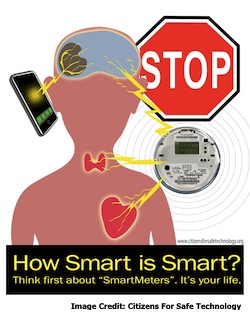About 200 customers of the Central Maine Power Company recently noticed something odd after the utility installed smart meters in their homes: in some cases other wireless devices stopped working, or behaved erratically.
The 425,000 installed smart meters all broadcast in the 2.4GHz frequency range. Unfortunately, so do many of the consumer gadgets we take for granted these days including routers, electric garage doors, fire alarms, clocks, electric pet fences, answering machines, and baby monitors.
 “We have asked CMP to do a better job informing customers about these potential problems, and while CMP’s website does refer to the issue, we don’t think it goes far enough,” said Maine’s Public Advocate Richard Davies in an online statement. “My agency is troubled by the possibility that people may be spending their time and money fixing a problem that may be caused by CMP’s meters, and that can and should be fixed by CMP.”
“We have asked CMP to do a better job informing customers about these potential problems, and while CMP’s website does refer to the issue, we don’t think it goes far enough,” said Maine’s Public Advocate Richard Davies in an online statement. “My agency is troubled by the possibility that people may be spending their time and money fixing a problem that may be caused by CMP’s meters, and that can and should be fixed by CMP.”
The utility’s Web site does include a FAQ addressing interference. Their recommendations are to change the location of the affected electronic device or the channel used by the device. In the case of garage door openers, physically relocating the garage is not an option. In the case of baby monitors, there is often only one frequency choice.
The electromagnetic congestion in the home is in some ways similar to the growing electronic congestion in hospitals as they acquire more and more electronic monitors all operating within a few feet of each other. Medical equipment has been known to shut down or give erroneous results when positioned close to another piece of equipment. Such interference is not new, just getting worse–rapidly.
As early as the 1940s, there was electromagnetic interference within the home. Radios and TVs broadcast at various frequencies but they were configured to co-exist. The electric vacuum cleaner was not. Nor the electric hair dryer. The worst offender, however, was perhaps the microwave oven, which, even in the 1940s, bombarded food with radio waves at or near the 2.4GHz range. Sensing there would be more congestion in the future, organizations worked to protect radio and TV, while carving out blocks that can be later used for consumer gadgets.

The International Telecommunication Union Radiocommunication sector (ITU-R) has since defined whole blocks of frequencies as unlicensed and generally available for Industrial, Scientific, and Medical use. And for a while, it seemed that there would be enough of these to last. While 900MHz and 5 GHz are also unlicensed options, 2.4GHz remains the most popular, offering the strongest signal strength over the broadest area without an unwieldy antenna. Hence most wireless gadgets in the home today broadcast at or near this frequency, including Bluetooth gadgets. That’s why you see FCC ratings on blenders.
So the trouble with the smart meters is at least understandable. Ideally, smart meters will one day communicate with your washing machine, dishwasher, refrigerator, and other energy intensive devices, allowing you to control energy usage, and potentially off-loading use to times when energy is cheap.
However, if the Bluetooth stereo component or the wireless router gets in the way, those energy readings could be wonky, and perhaps the energy savings as well.
If a device can’t be moved, perhaps it will allow you to change the channel being used. Most devices today default to channel six, but channels one and eleven are also viable options—at least for routers. I recently upgraded the plumbing in my house and found all my laptops no longer connected with the router. The reason? The copper tubing changed the local interference pattern among all my electronic gadgets. But once I changed the router’s channel, I was back in business.
Given that we can’t change the smart meters ourselves, it looks like consumers will have to get good at fixing their own electronic issues once their home becomes “metered.”
You May Like: Man-in-the-Middle Attacks on Voting Machines













